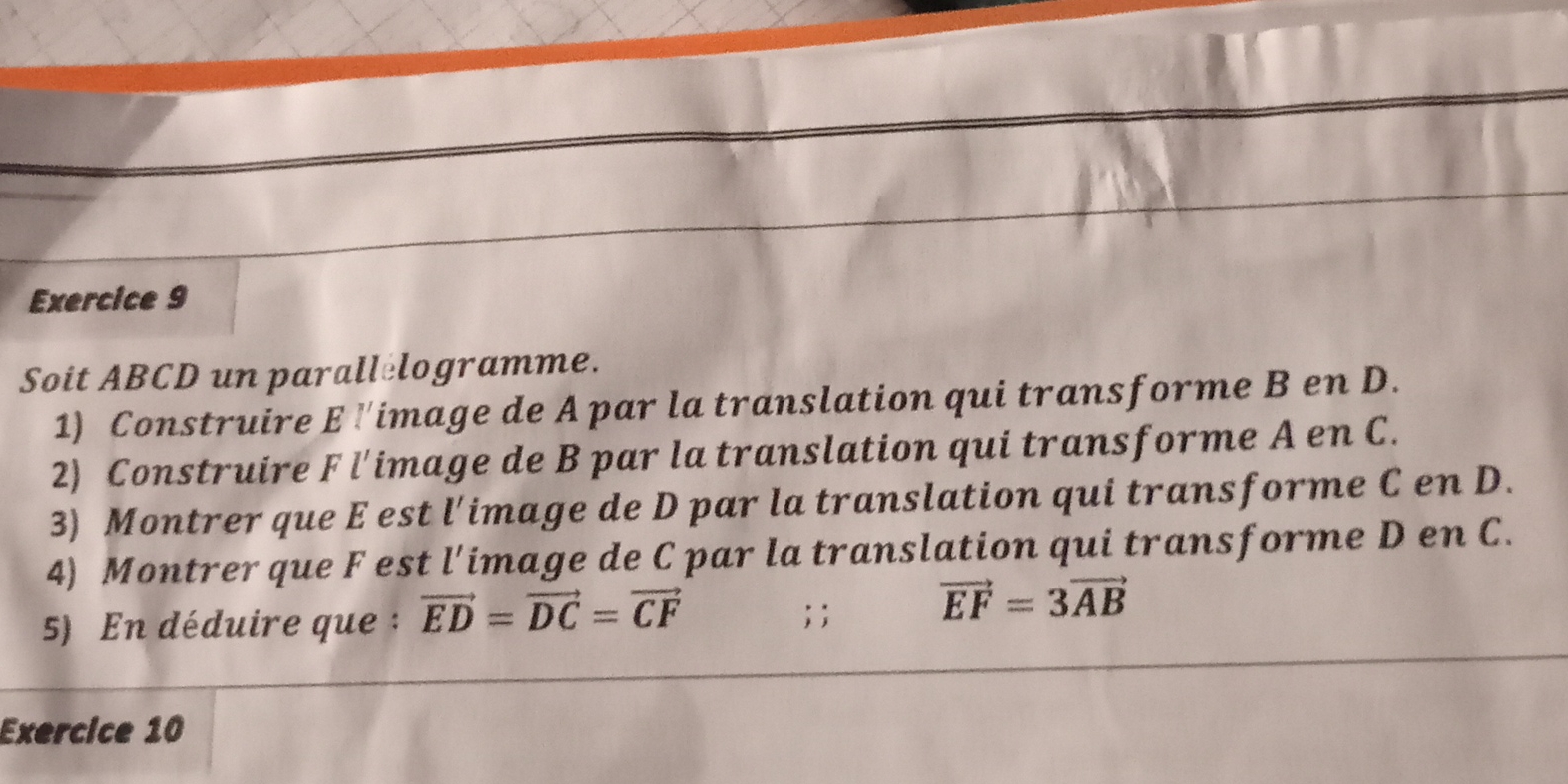Soit \(ABCD\) un parallelogramme. 1. Construire \(E\) l'image de \(A\) par la translation qui transforme \(B\) en \(D\). 2. Construire \(F\) l'image de \(B\) par la translation... Soit \(ABCD\) un parallelogramme. 1. Construire \(E\) l'image de \(A\) par la translation qui transforme \(B\) en \(D\). 2. Construire \(F\) l'image de \(B\) par la translation qui transforme \(A\) en \(C\). 3. Montrer que \(E\) est l'image de \(D\) par la translation qui transforme \(C\) en \(D\). 4. Montrer que \(F\) est l'image de \(C\) par la translation qui transforme \(D\) en \(C\). 5. En déduire que : \(\overrightarrow{ED} = \overrightarrow{DC} = \overrightarrow{CF}\) et \(\overrightarrow{EF} = 3\overrightarrow{AB}\)

Understand the Problem
L'exercice porte sur les translations dans un parallélogramme. Il faut construire des points en utilisant des translations, puis démontrer certaines propriétés liées à ces transformations et enfin déduire des égalités vectorielles. Plus précisément:
- On donne un parallélogramme ABCD.
- Il faut construire les points E et F, images de A et B par certaines translations.
- Il faut montrer que E et F sont aussi les images de D et C par d'autres translations.
- Enfin, il faut déduire des égalités vectorielles concernant les vecteurs ED, DC, CF et EF.
Answer
$\overrightarrow{ED} = \overrightarrow{DC} = \overrightarrow{CF}$ ; $\overrightarrow{EF} = 3\overrightarrow{AB}$
Answer for screen readers
$\overrightarrow{ED} = \overrightarrow{DC} = \overrightarrow{CF}$
$\overrightarrow{EF} = 3\overrightarrow{AB}$
Steps to Solve
- Understanding the translations
We are given that $E$ is the image of $A$ by the translation that maps $B$ to $D$. This means $\overrightarrow{AE} = \overrightarrow{BD}$. Also, $F$ is the image of $B$ by the translation that maps $A$ to $C$. This means $\overrightarrow{BF} = \overrightarrow{AC}$.
- Parallelogram properties
Since ABCD is a parallelogram, $\overrightarrow{BD} = \overrightarrow{BA} + \overrightarrow{AD}$ and $\overrightarrow{AC} = \overrightarrow{AB} + \overrightarrow{BC}$.
- Showing E is the image of D by the translation that maps C to D
We want to show that $E$ is the image of $D$ by the translation that transforms $C$ to $D$, i.e., we need to prove $\overrightarrow{DE} = \overrightarrow{CD}$. We know $\overrightarrow{AE} = \overrightarrow{BD}$, so $\overrightarrow{AE} = \overrightarrow{AD} + \overrightarrow{DE}$. Thus, $\overrightarrow{DE} = \overrightarrow{AE} - \overrightarrow{AD}$. Since $\overrightarrow{AE} = \overrightarrow{BD}$, we have $\overrightarrow{DE} = \overrightarrow{BD} - \overrightarrow{AD}$. Also, since $ABCD$ is a parallelogram, $\overrightarrow{BD} = - \overrightarrow{DB}$, and $\overrightarrow{DB} = \overrightarrow{AB} - \overrightarrow{AD}$.
We also have $\overrightarrow{CD} = - \overrightarrow{DC}$, and since $ABCD$ is a parallelogram, $\overrightarrow{DC} = \overrightarrow{AB}$. Therefore, we want to show that $\overrightarrow{DE} = - \overrightarrow{AB}$. Since $\overrightarrow{AE} = \overrightarrow{BD}$, we have $\overrightarrow{OE} - \overrightarrow{OA} = \overrightarrow{OD} - \overrightarrow{OB}$. Thus, $\overrightarrow{OE} = \overrightarrow{OA} + \overrightarrow{OD} - \overrightarrow{OB}$. Now, $\overrightarrow{DE} = \overrightarrow{OE} - \overrightarrow{OD} = \overrightarrow{OA} - \overrightarrow{OB} = \overrightarrow{BA} = - \overrightarrow{AB}$. Thus we have proved $\overrightarrow{DE} = \overrightarrow{CD}$. So, $E$ is the image of $D$ by the translation that transforms $C$ to $D$.
- Showing F is the image of C by the translation that maps D to C
We want to show that $F$ is the image of $C$ by the translation that transforms $D$ to $C$, i.e., we need to prove $\overrightarrow{CF} = \overrightarrow{DC}$. We know $\overrightarrow{BF} = \overrightarrow{AC}$, so $\overrightarrow{CF} = \overrightarrow{BF} - \overrightarrow{BC} = \overrightarrow{AC} - \overrightarrow{BC}$. Since $ABCD$ is a parallelogram, $\overrightarrow{AC} = \overrightarrow{AB} + \overrightarrow{BC}$. Thus, $\overrightarrow{CF} = \overrightarrow{AB} + \overrightarrow{BC} - \overrightarrow{BC} = \overrightarrow{AB}$. Also, since $ABCD$ is a parallelogram, $\overrightarrow{DC} = \overrightarrow{AB}$. Therefore, $\overrightarrow{CF} = \overrightarrow{DC}$. So, $F$ is the image of $C$ by the translation that transforms $D$ to $C$.
- Deductions
From step 3, we have $\overrightarrow{DE} = \overrightarrow{CD}$, so $\overrightarrow{ED} = \overrightarrow{DC}$. From step 4, we have $\overrightarrow{CF} = \overrightarrow{DC}$. Therefore, $\overrightarrow{ED} = \overrightarrow{DC} = \overrightarrow{CF}$.
Now let's find $\overrightarrow{EF}$. We have $\overrightarrow{EF} = \overrightarrow{ED} + \overrightarrow{DC} + \overrightarrow{CF}$. Since $\overrightarrow{ED} = \overrightarrow{DC} = \overrightarrow{CF}$, we have $\overrightarrow{EF} = \overrightarrow{DC} + \overrightarrow{DC} + \overrightarrow{DC} = 3\overrightarrow{DC}$. Since $ABCD$ is a parallelogram, $\overrightarrow{DC} = \overrightarrow{AB}$. Therefore, $\overrightarrow{EF} = 3\overrightarrow{AB}$.
$\overrightarrow{ED} = \overrightarrow{DC} = \overrightarrow{CF}$
$\overrightarrow{EF} = 3\overrightarrow{AB}$
More Information
The problem demonstrates properties of translations in the context of a parallelogram, showing how translations preserve vector relationships and how to derive equalities based on these relationships.
Tips
A common mistake is to not use the properties of the parallelogram correctly, such as the equality of opposite sides as vectors and the relationships between diagonals. Another mistake could be errors in vector addition or subtraction.
AI-generated content may contain errors. Please verify critical information